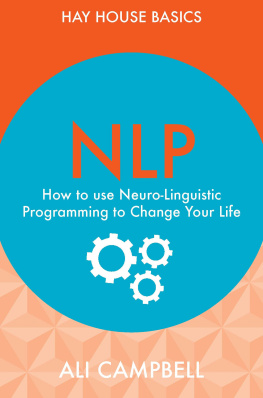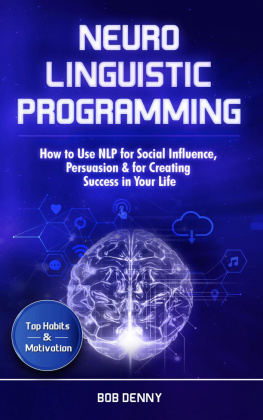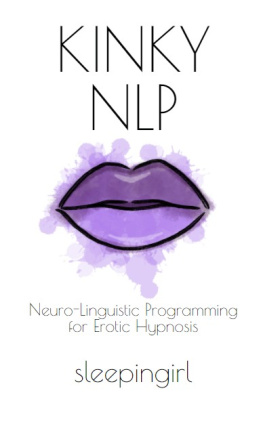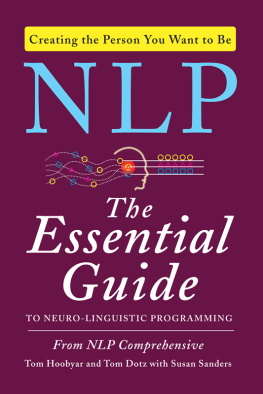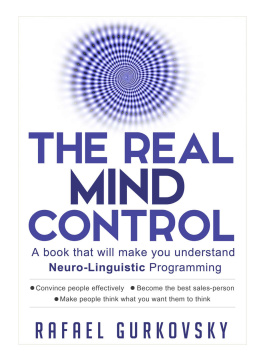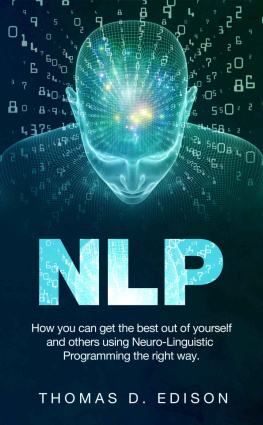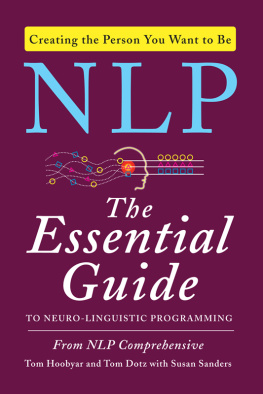NLP
Neuro-Linguistic Programming
Reach Your True Potential with NLP, Hypnosis, Mind Control, Communication Skills - Increase Your Confidence & Achieve Success
Table of Contents
Introduction: What is NLP?
D id you know you can put a stop to your bad habits like smoking or eating junk food through hypnosis? Think about how much this could change your life and help you open a door to a more successful life! Did you know you can learn many new and interesting things through NLP practices that may help you better yourself and your life? Although you may have been unaware, there are many ways you can use NLP methods to improve yourself and your life!
Your first question, however, may be: What exactly is Neuro-Linguistic Programming? Its possible youve never even heard this term before, let alone know what it means and what its all about! This is a fair and extremely important question! When learning about any new topic, its vital to understand the foundations of it. This could not be truer for the topic of NLP as well!
Neuro-Linguistic Programming was created in the 1970s by a pair of self-help trainers in California. It is an approach that attempts to help communication skills, psychotherapy and personal development.
Based on the idea of this therapy, there is a connection between our brains (neuro) and language (linguistic) as well as learned behavioral patterns (programming). It is believed these three things can be changed to alter and hopefully, improve ones behavior or accomplish specific goals. The creators of this approach and many who practice or use it claim an entire slew of issues, problems and obstacles in life can be solved through this self-help therapy. Depression, addictions, phobias, allergies, the common cold, or learning disorders are just a few believed to be treatable through this therapy. There have even been claims that some have been treated in as short as a single session!
There are also many different strategies and types of Neuro-Linguistic Programming and in the coming chapters, we will explore how you can implement them into your life to make positive changes that will, hopefully, lead to important personal success! A few of these strategies are hypnosis, memory alterations and reframing. Although these may seem like very foreign and even strange concepts to you now, dont worry! This book will help you to explore many of the different NLP topics and help you to understand just what they are! Lets begin!
Chapter 1 NLP and Depression
I f youre like millions of people in the world who struggle with depression, this is an important chapter for you! Although depression can be treated and handled in a number of ways, Neuro-Linguistic Programming might be another option for you! You may have tried other options or strategies in the past and maybe they havent worked or they havent helped you in the way youve hoped. You may even be hoping to try a form of treatment that avoids and doesnt require medication. Whatever reason you have sought out this book and therefore, this chapter, there is no doubt you will gain valuable information on the topic and how to use it in your own specific way.
The first strategy of discussion is called reframing . Basically, this means to see the situation in a different light or to put a different spin on it so you can view it differently! This strategy is meant to help you look at the more positive side of things, rather than any negative aspects. An example of this would be the following scenario: Imagine you have a son or daughter that often acts unruly. Always disagreeing and stating their strong opinion. For many, this may be frustrating and you may view it as disrespectful or a negative personality trait on their part. However, when practicing reframing, you would instead want to realize that your son or daughter is independent and strong minded in a good way and that this could be very helpful and beneficial to them in the future.
Maybe instead of being upset by this, you may want to think of it in a more positive way and be happy about it. To help you out even more, you can use a step-by-step process to help you change your thinking and get you more accustomed to reframing.
The first step you would want to practice is to identify your bad or unwanted behavior. This may be addictive sleeping, procrastinating, comfort eating or sloppy time management skills. This will involve begin brutally honest with yourself to admit whats really wrong. Now, internally communicate with the part of the body that is associated with the negative behavior. This is your way of mentally and verbally recognizing that, one, there is a problem and, two, youre confronting it.
Next, choose a positive intention and reaction to the negative behavior. For example, if you think a friend is mad at you and your afraid youre going to get in a fight with them, instead of choosing the negative reaction, like, getting defense and yelling at your friends, try to instead think about how you can act calm, cool and collected just in case there ends up being any confrontation. Step number four is to find three different approaches to a problem. Brainstorm different ways you could approach the situation and make sure their all on positive rather than negative.
Now, evaluate these three different approaches and ask your subconscious to accept them. You will feel your body accept the ideas when it feel as peace and calm about the ideas. If your body and mind seems to reject the ideas, reassess the three previous ideas you just had and them try this step again. Now, think ahead to how this new, learned behavior will affect you in future situations as well as relationships. Will the change be positive? Does your body and mind acceptthis behavior? Do you feel that this is the best course of action? How will this behavior affect your work and social life? These are all important questions to be asking yourself at the end and final step of reframing.
The next NLP strategy you can use to combat your depression is called memory manipulation. This strategy is all about a situation and how you view it based on your personality, beliefs, morals and opinions. What is so interesting about this topic is that two different people, who witness the very same event or experience the very same situation, can have completely different viewpoints of it. This is because everyone, based on their personality, morals and beliefs interprets the event or situationcompletely different than the personal standing right beside them.
To understand thisstrategy, lets attempt a little exercise. First, think about a significant memory that you fell a certain way about but you wish you felt differently. You will want to choose a memory that there is still quite a bit of emotion attached to, so you may find that this memory is somewhat recent or of great importance to you. It also means that this memory is also one you feel discomforted and upset by and you therefore; wish there had been a different outcome and lasting memory. Now, do your best to relive this memory. Go back into your mind and watch yourself within the memory.
Remember every single detail that you can. Sights, smells, location, the people (if any) that were there and any conversation that may have happened. Now, after remembering it one time through, remember it again but this time, put a boarder around it as youre seeing it. It can be a boarder of anything. Flowers, a solid color, food, rainbowsanything. Now, see if this changes how youre feeling about it. Now try remembering it again but this time, remember it and play it through in your head in black and white.
How do you feel now? Is the memory better? Keep remembering your specific, chosen memory and keep making these small changes until you feel an emotional change behind the changes. Whatever makes you feel most positive and even happy, then keep that change. Now, you can begin to play around with the memory you have of the people in your memory as well. If you feel anger towards the person or people in your memory, try imagining them instead in a funny way. For example, you can imagine your boss as a giant marshmallow or your mother with the face of a cow. Try to find something that makes you laugh and thus, changes the emotion that goes with this memory.Finally, you can play around with the sounds you remember in specific memories to change how you remember them and the emotions surrounding them.
Next page


